No products in the cart.
NEWS
Growing Cabbage: An Expert Guide to Bountiful Harvests
Cultivating your own fresh cabbage is a rewarding experience, whether you’re a seasoned gardener or just starting out. Known for its crisp texture and versatility in the kitchen, cabbage is a cool-season crop that can thrive in many home gardens. Getting prepared with the right knowledge is key to success. This comprehensive guide, brought to you by the experts at Biogarden.Asia, will walk you through every step of growing healthy, vibrant cabbage plants, from selecting the perfect variety to managing pests and harvesting your well-earned heads.
Choosing the Right Cabbage Variety
Cabbage comes in a surprising array of shapes, sizes, and colors, each with its own unique characteristics. Selecting the right variety for your climate and culinary needs is the first step towards a successful harvest. You’ll find everything from dense, round heads perfect for coleslaw to crinkly-leaved types ideal for cooking.
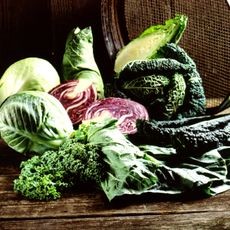 Assortment of different cabbage varieties, including green, red, and savoy types.
Assortment of different cabbage varieties, including green, red, and savoy types.
- Green Cabbage: The most common type, typically forming tight, round or slightly pointed heads. Varieties like ‘Golden Acre’ are prized for their compact size and early maturity, making them excellent for smaller gardens or shorter growing seasons. ‘Late Flat Dutch’ is known for producing large, firm heads that store well. ‘Charleston Wakefield’ is a heat-tolerant heirloom variety often favored in warmer climates, producing distinctive conical heads.
- Red Cabbage: Adds a beautiful splash of color to salads and slaws. Varieties like ‘Kaibos Red’ offer vibrant purple heads.
- Savoy Cabbage: Easily identifiable by its deeply crinkled, loose leaves and milder flavor compared to green cabbage. ‘Deadon Savoy’ is a tasty option for fall and early winter harvests.
- Unique Varieties: Some cabbages stand out, like the ‘Walking Stick Cabbage,’ known for its tall, sturdy stem that can be dried and used. ‘Colewort’ is another interesting type, representing an older form of cabbage.
Consider the maturity time listed for each variety when making your choice, especially if you have a short growing season.
Site Selection and Soil Preparation
Cabbage plants are heavy feeders and require nutrient-rich, well-drained soil to form those desirable dense heads. Choose a location that receives at least 6 hours of direct sunlight per day.
Prepare the planting bed by incorporating a generous amount of organic matter, such as compost or well-rotted manure. This improves soil structure, drainage, and fertility. Cabbage prefers a slightly acidic to neutral soil pH, ideally between 6.0 and 7.0. As soil scientist Dr. Clara Jensen notes, “Ensuring the correct soil pH unlocks essential nutrients for cabbage plants, preventing deficiencies and promoting vigorous growth.” If your soil is too acidic, you can add lime to raise the pH.
Planting Your Cabbage
Cabbage is a cool-season crop that can tolerate light frost, making it suitable for spring and fall planting in many regions.
- Starting Seeds Indoors: For an early start, sow seeds indoors 4-6 weeks before your last expected spring frost. Plant seeds about 1/4 inch deep in seed starting mix. Keep the soil moist and provide adequate light.
- Direct Sowing: You can also sow seeds directly into the garden bed after the danger of hard frost has passed. Follow spacing recommendations for the specific variety, typically planting seeds 1-2 inches apart and thinning later.
- Transplanting: Harden off indoor-started seedlings gradually before transplanting them into the garden bed. Plant seedlings at the same depth they were growing in their containers. Proper spacing is crucial; give plants enough room to develop large heads, usually 12-24 inches apart depending on the variety, in rows 2-3 feet apart.
Essential Care for Thriving Cabbage
Once planted, consistent care is key to healthy cabbage growth and successful head formation.
- Watering: Cabbage needs consistent moisture, especially as the heads begin to form. Water deeply and regularly, aiming for about 1-1.5 inches of water per week, adjusting for rainfall. Avoid letting the soil dry out completely, which can stress the plants and lead to stunted growth or split heads.
- Fertilizing: As heavy feeders, cabbage plants benefit from supplemental feeding. About three weeks after transplanting or thinning, and again two to three weeks later as heads start to develop, apply a balanced organic fertilizer or a side dressing of compost. Biogarden.Asia’s range of organic plant support products can provide the necessary nutrients for robust growth.
- Sunlight: Ensure plants receive full sun exposure throughout the day.
- Weeding: Keep the area around your cabbage plants free of weeds, which compete for water and nutrients. Mulching can help suppress weeds and retain soil moisture.
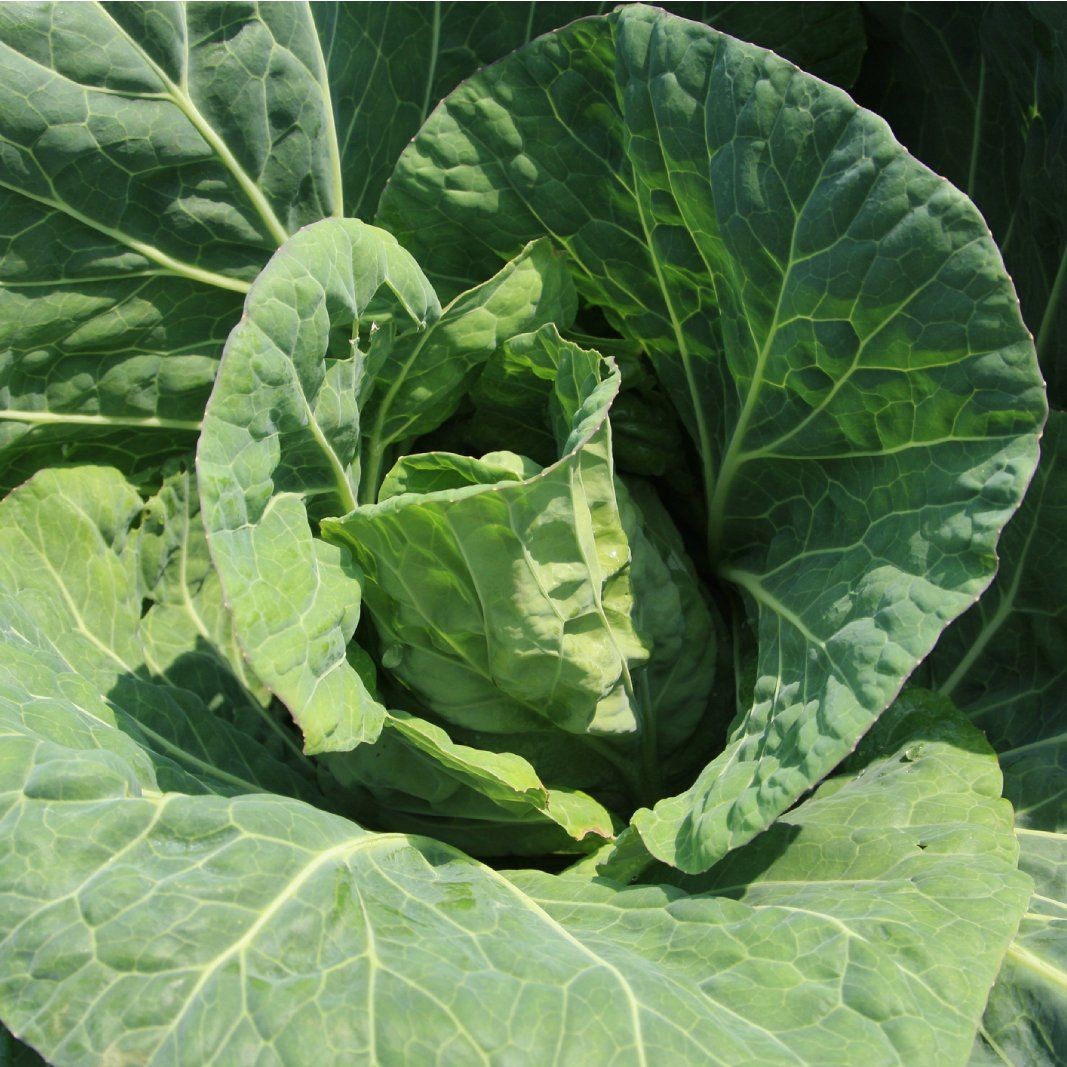 Close-up view of a healthy green cabbage head growing in the garden.
Close-up view of a healthy green cabbage head growing in the garden.
Growing Cabbage in Containers
Don’t have a large garden bed? No problem! Cabbage can be successfully grown in containers, making it accessible for patios, balconies, and small spaces. Choose large pots, at least 10-12 inches in diameter and depth, to accommodate the plant’s root system and head size. Use a high-quality potting mix and ensure the container has drainage holes. Container-grown cabbage will likely require more frequent watering and feeding than those in the ground due to the limited soil volume.
Companion Planting for Cabbage
Companion planting involves growing certain plants together to enhance growth, deter pests, or attract beneficial insects. For cabbage, good companions include herbs like dill, mint, rosemary, and thyme, which can help repel cabbage moths and other pests. Celery, onions, and garlic are also considered beneficial neighbors. Avoid planting cabbage near other brassicas (like broccoli, kale, or cauliflower) to prevent the spread of shared pests and diseases. Strawberries are also not ideal companions for cabbage.
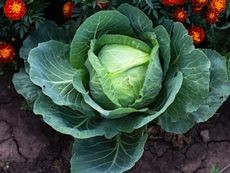 Various plants growing together, illustrating the concept of companion planting around cabbage.
Various plants growing together, illustrating the concept of companion planting around cabbage.
Dealing with Cabbage Pests and Diseases
Like most crops, cabbage can be susceptible to certain pests and diseases. Common issues include:
- Pests: Cabbage worms, aphids, slugs, and flea beetles are frequent visitors. Regularly inspect your plants. Organic control methods include hand-picking worms, using insecticidal soap for aphids, setting slug traps, or covering young plants with fine mesh row covers to prevent pests from landing.
- Diseases: Clubroot and black rot are common diseases. Prevention is the best approach. Practice crop rotation (don’t plant cabbage or other brassicas in the same spot year after year), ensure good air circulation, and use disease-resistant varieties when possible.
Harvesting Your Cabbage
Your cabbage is ready to harvest when the head is firm and feels solid when squeezed. The maturity time varies by variety, typically ranging from 55 to 80 days after transplanting. To harvest, use a sharp knife to cut the head at the base, leaving the outer leaves and stem in the ground. Sometimes, smaller side heads may develop on the stem after the main head is removed, offering a bonus harvest.
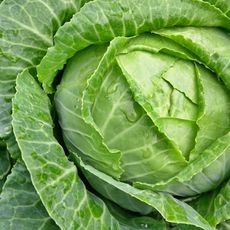 Detailed view of the tightly formed head of a green cabbage.
Detailed view of the tightly formed head of a green cabbage.
Pruning Cabbage Leaves
While you don’t “prune” the cabbage head itself (that’s harvesting!), you might occasionally remove some of the outer leaves. This can be beneficial if the lower leaves are touching the soil and beginning to rot, or if they are excessively shading surrounding plants. Removing these older, yellowing, or damaged leaves can improve airflow around the plant, potentially reducing disease risk.
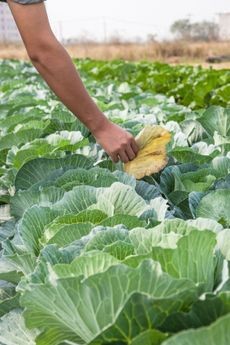 Outer leaves being removed from a cabbage plant.
Outer leaves being removed from a cabbage plant.
Beyond the Basics: Unique Cabbage Facts
Cabbage isn’t just for eating! For instance, the vibrant red cabbage can be used as a fun, natural pH indicator for testing your soil at home – its juice changes color depending on acidity levels. Cabbage also has a rich history, with types like the French ‘Aubervilliers’ having specific regional origins, and even a designated ‘National Cabbage Day’ in some places, highlighting its long-standing importance in diets worldwide.
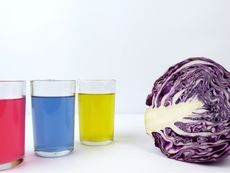 Red cabbage half next to glasses of liquid showing color changes from a pH test.
Red cabbage half next to glasses of liquid showing color changes from a pH test.
Conclusion
Growing cabbage is a rewarding endeavor that provides delicious, healthy produce straight from your garden. By understanding the basics of variety selection, soil preparation, planting, and ongoing care, you can minimize challenges and maximize your harvest. Whether you choose a classic green, a colorful red, or a delicate savoy, the satisfaction of cutting a fresh, firm head of cabbage you grew yourself is unparalleled. Start your cabbage growing journey today, and explore Biogarden.Asia’s resources and products to support your gardening success every step of the way!



